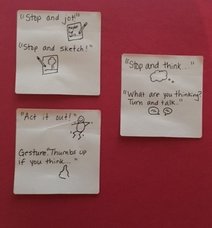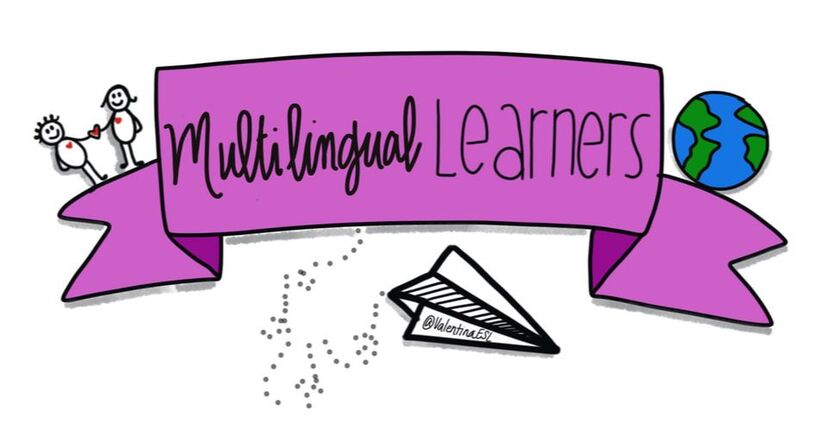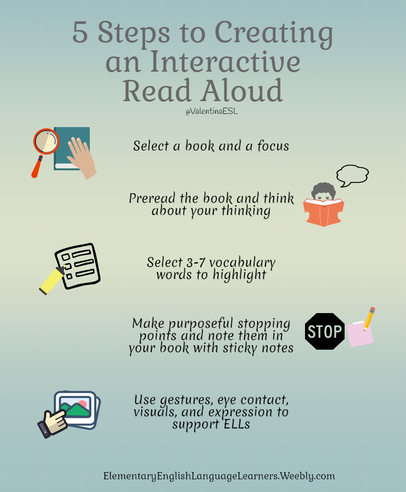|
Do you remember when you were in school and your teacher said it was time for read aloud? I don't know about you, but for me, that was a joyous time. It was a time for my imagination to soar. I could take the words that were flowing so eloquently from her mouth and create a movie in my mind. I love it. As a classroom teacher, reading aloud to my own students became my favorite thing to do (maybe because it was magical for me as a child). I wanted to share that experience with them. But I also wanted to lift the level of learning a notch. Rather than this time being only for input, I was hoping to create some opportunities for output as well. ENTER Interactive Read Alouds! In a traditional read aloud, the experience is a one way street. The teacher reads and the students listen. There is no interaction, discussion, or time for students to express themselves during the read aloud. It's probably what I disliked most about read aloud when I was a kid. No one was allowed to talk while the teacher read. On the contrary, during an Interactive Read Aloud, the teacher provides ample opportunities for students to interact with the text. Students talk with a partner, act out parts of the book, draw a picture related to the reading, or respond in writing. The best Interactive Read Alouds are carefully pre-planned by the teacher. The teacher can stop to ask questions or have students respond at critical parts of the book when the planning is done ahead of time. The term interactive refers to the active learning that occurs while reading aloud high-quality literature. It characterizes the teacher and students having a conversation as they process the text together. It provides students an opportunity to extend their understandings through talk. This talk provides evidence of their thinking. (Fountas & Pinnell, 2001, 2011) In both cases, whether traditional read aloud or interactive, the teacher models proficient reading so students can hear what an expert reader sounds like and how a reader engages with text. The teacher also models thinking about the text. What is happening? What is the character doing and why? What am thinking now? Basically, students get to hear what happens in the reader's head. They are also able to experience a text that is at a higher level than they are capable of reading on their own. Steps to creating your own Interactive Read Aloud: •Select a book and a focus •Preread the book and think about your thinking •Select 3-7 vocabulary words or phrases to highlight •Make purposeful stopping points and note them in your book with a sticky note •Use gestures, eye contact, visuals and expression to support ELLs In this video, Linda Hoyt explicitly demonstrates with students how to talk to your Thinking Partner while she shares an Interactive Read Aloud on a nonfiction book. (5 minute clip) https://www.youtube.com/watch?v=qYoeVkf3s7E The value of a read aloud, whether it be interactive or not, cannot be underestimated. Children of all ages benefit from being read to regularly. I'm an advocate for daily! This TED Talk by Rebecca Bellingham speaks volumes about the benefit of reading aloud. If you have 9 1/2 minutes to spare, watch it and then share it with teachers and parents! We all need a reminder every now and then. Research has demonstrated that the most effective read-alouds are those in which children are actively involved asking and answering questions and making predictions rather than passively listening (Dickinson, 2001).  Resources: Calkins, L. (2015). Units of study for teaching reading. Portsmouth, NH: Heinemann. Hoyt, L. (2007). Interactive read-alouds. linking standards, fluency, and comprehension. Portsmouth, NH: First Hand Heinemann.
Wade Wilshusen
5/30/2017 03:28:59 pm
Good read. There are few things more fun to do than read-alouds! I always felt that, since most kids are reading their own books on their own level, it is good to have a story that you can all reference in mini-lessons.
Valentina
5/31/2017 09:24:23 pm
I agree, Wade. Not only does a read aloud give the class a common book to discuss and build community but it also models critical reading skills that not all readers have mastered.
Gabriela Garza
6/28/2020 03:11:45 pm
I wonder if the visual support could be just pictures, since I teach special education for 4 and 5 year olds. I could probably use my pictures when I do my read alouds.
Mrs. W
10/30/2017 12:19:46 pm
Another thoughtful and helpful post. Thank you!
Anne
6/22/2020 10:27:20 am
Great read! I found these 2 facts to be true. During a read aloud, the teacher should give ample time for the students to interact with the text by answering and asking questions about the story.
Gabriela Garza
6/28/2020 02:29:05 pm
I agree. And modeling how to talk and ask questions about the story before expecting them to do that. Turn and talk is great for this well.
Gabriela Garza
6/28/2020 02:26:38 pm
During a read aloud having planned stopping points throughout the story and giving the students time to talk and ask questions to each other and with the teacher is important.
Blanca
7/20/2020 03:17:15 pm
During the read aloud it is important to give students think and talk time. Comments are closed.
|
Categories
All
|



 RSS Feed
RSS Feed
